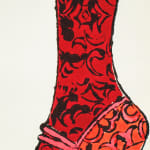Andy Warhol
Further images
Gee, Merrie Shoes represents one of the more elusive works from Andy Warhol’s mid-1950s practice, a moment when the artist was actively blurring the lines between commercial design and fine art. Though clearly derived from imagery included in the portfolio À la recherche du shoe perdu, this impression exists as a unique variant rather than a standardized edition print. Its status outside the formal suite underscores Warhol’s improvisatory approach to printmaking at this stage: images could migrate, reappear, and mutate across different formats, resisting the fixed boundaries of “work” and “edition” that traditionally defined the field of prints and drawings.
Visually, the composition is striking in its vertical emphasis. A single ornate boot and shoe, patterned with curling arabesques in deep red and black, occupies the right edge of the sheet, while the remainder is left intentionally blank. This asymmetry produces a sense of both elegance and whimsy: the image hovers between fashion illustration and autonomous artwork. The hand-lettered caption at the bottom—Gee, Merrie Shoes—operates as a punning commentary, continuing Warhol’s strategy of playfully reworking idiomatic expressions into shoe-centered witticisms. Here, the shoe itself seems to stand in for character and narrative, suggesting that footwear might tell stories as complex as those found in literature or cinema.
The material qualities of this sheet distinguish it further. Measuring smaller and squarer than the standard plates of À la recherche du shoe perdu, it demonstrates how Warhol allowed scale and format to remain flexible. Its unique coloration—hand-applied washes of red and orange—marks it as an object of variation, not repetition. In contrast to the later silkscreen practice that emphasized mechanical uniformity, this work preserves the evidence of the artist’s (and his circle’s) direct touch. Each such variant complicates the narrative of Warhol as a purely mechanized producer, reminding us that his earliest experiments were suffused with craft, play, and intimacy.
Biographically, the sheet reflects Warhol’s liminal position in New York in the mid-1950s. Still making a living through advertising commissions, he was at the same time cultivating a body of work that could be circulated among collectors and curators. Unique variants like Gee, Merrie Shoes may have functioned as gifts, presentation pieces, or exploratory trials, testing how commercial motifs could be reframed as fine art. They also speak to Warhol’s collaborative household: the whimsical lettering style, indebted to his mother Julia Warhola’s script, infuses the work with a sense of domestic intimacy within a commercial idiom.
Seen within the larger arc of Warhol’s oeuvre, Gee, Merrie Shoes occupies a pivotal position. It crystallizes the moment before Warhol’s decisive embrace of Pop, when his practice was still tethered to the conventions of illustration yet straining toward the autonomy of fine art printmaking. As a unique variant, it serves as evidence of Warhol’s experimentation with image, language, and format, highlighting his fascination with the shoe as both commodity and metaphor. Rather than a mere offshoot of the portfolio, Gee, Merrie Shoes can be read as a testament to the fluidity and inventiveness of Warhol’s early print practice, a work that encapsulates the wit, fragility, and ambition of an artist on the verge of reconfiguring the visual culture of his time.
NOTES
With the Estate of Andy Warhol and Andy Warhol Art Authentication Board inkstamps on the verso, initialed ‘T.J.H.’ by Timothy J. Hunt, and inscribed with inventory number in pencil.
Provenance
The Estate of Andy Warhol, New YorkThe Andy Warhol Foundation, Inc., New York
Private collection, United States








